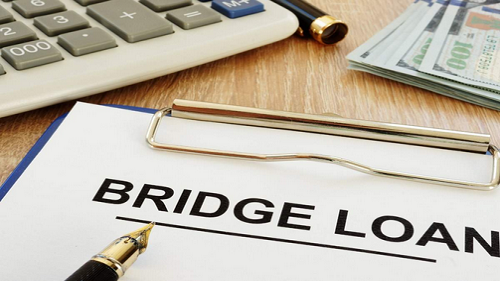
Mortgage Dove
Bridge Loans: Definition and Process
Bridge loans are commonly utilized in real estate deals to offer financial support during transition, such as moving from one home to another. These short-term loans can help homeowners quickly put more money in their pockets by financing a new home or paying off existing debt obligations. Like any other form of financing, bridge loans have advantages and disadvantages. Here is an overview of what bridge loans are and how they work.
An Overview of Bridge Loans
Providing immediate cash flow allows the borrower to meet current obligations. Bridging loans are frequently used in real estate, also known as bridge financing or bridging loans. Typically, bridge loans are used until a person or company can secure permanent financing or pay off existing debt. The interest rates on bridge loans are relatively high and usually require collateral such as real estate or inventory.
Most home sellers would prefer to wait to make an offer on a new property until their current property has been sold and use the proceeds to finance their new purchase. Even if you cannot sell your property, bridge financing can provide you with the funds you need to purchase a new home . A bridge loan allows you to borrow money from additional funds or the equity in your current home before you sell it to buy new property.
There are many instances when homeowners make sudden transitions (for example, moving quickly to another location for work) and need a way to bridge the gap between the two homes. Suppose you're looking for a new home in a competitive market. In that case, it's possible to avoid making offers contingent on selling your current property with some assistance. These offers allow you to withdraw from the contract if you cannot sell your current home, which is why buyers choose not to pursue this option. This transitory period can be financed with a bridge loan. Although bridge loans are secured with your existing home, they aren't meant to replace long-term financings, such as a traditional mortgage or other types of home loans. They are intended to be repaid within one to three years. Since bridge loans are non-mortgage or special financing, they are not considered mortgages.
The Bridge Loan Process
Bridge loans are used when financing is needed but have not been available. They are also known as interim financing, gap financing, or swing loans. Lenders can customize bridge loans for various situations, and they are used by individuals and companies alike.
Suppose you want to purchase a new home but need to sell your current one first. In that case, you can borrow against the equity in your existing home to get the funds you need. Bridge loans are available for homeowners waiting for their current homes to sell. These loans generally have a higher interest rate than home equity lines of credit (HELOCs) . While homeowners wait for their homes to be ready, a bridge loan gives them extra time.
Residential bridge loans are commonly used for the following reasons:
- Having trouble affording a down payment before selling your current home
- The need to find a new home as soon as possible
- Closing dates for new purchases are scheduled after the sale of your previous home
- Listing your current residence before securing a new one
- Contingent offers aren't welcome by sellers in your desired area
For those seeking bridge loans, there are two main options:
- To use the bridge loan to pay for their new home's down payment until they can sell their old one
- Pay off their old home's mortgage with one large loan and use the remaining money to put down on their new house
A bridge loan is likely to:
- Term lengths of six months or one year
- Collateralize the borrower's current home
- Obtain only from lenders who are willing to finance your new mortgage
- Vary in interest rates, generally hovering slightly above prime rates
A bridge loan can be applied for in the same way as a conventional mortgage. To qualify for a bridge loan package, you must have at least 20% equity in your current home and additional financial qualifications. Additionally, bridge loan institutions typically offer borrowing limits of up to 80% of the property's loan-to-value ratio (LTV) . When considering your application, your loan officer will consider several factors, including your credit score , credit history, and debt-to-income ratio (DTI).
Average Rate For A Home Bridge Loan
Bridge loans are generally associated with higher interest rates than conventional loans - including rates that are typically around 2% above prime. Besides closing costs, bridge loans also require origination fees (which can be several thousand dollars on top of the loan's value). Additionally, you may have to pay for an appraisal.
Before accepting any bridge loan offer, carefully read and understand the terms and conditions that come with it. However, you should be aware that protections for buyers are often limited if their current home sale falls through. Your existing property secures bridge loans, so if payments are not made, they can be repossessed by a lender. In light of this, you'll want to carefully consider how long you can afford to go without financial relief if the sale stalls and avoid borrowing too much money. It's also worthwhile to conduct extensive research on your area's current real estate market and how long it takes for homes to sell.
Bridge Loans: Pros and Cons
Bridge loans come with advantages and disadvantages, just like any other type of financing. Here are the upsides and downsides of this type of borrowing:
Pros
- Before selling your current home, you can purchase a new one with a bridge loan.
- The sale contingency does not have to be implemented when you offer a new home.
- The plan also provides additional funding for sudden or time-sensitive transitions.
- A short-term loan is a helpful way to finance your way through uncertain times.
- The first few months may be free of monthly payments.
- You can make interest-only payments or deferred payments until you sell the property.
Cons
- It is common for bridge loans to have higher interest rates and annual percentage rates.
- Lenders generally require homeowners to have 20% home equity before offering a bridge loan.
- It is common for financial institutions to extend a bridge loan only if you are also applying for a new mortgage with them.
- The stress of managing two mortgages can be overwhelming if you own two houses simultaneously.
- You may have future issues with the sale of your property or even have to go through foreclosure in the worst-case scenario.
Obtaining bridge loans from many lenders, including banks, credit unions, and other financial institutions, is possible. This type of program is usually originated by the mortgage provider you currently have. If you're interested in a bridge loan, you should speak with your lender first.
When searching for a financing partner, be wary of lenders offering quick access to capital, charging exorbitant rates, and needing a better track record of performance or customer service.
Bridge Loans vs. Traditional Loans
Compared to traditional loans, bridge loans typically have a faster approval, funding, and application process. The drawback is that these loans usually have short terms, high-interest rates, and high origination fees in exchange for convenience.
In general, borrowers accept these terms because they need quick and convenient access to funds. As long as they have low-interest, long-term financing, they will pay high-interest rates on short-term loans. Additionally, most bridge loans have no repayment penalties.
Conclusion
When you need a new home before an old one sells, a bridge loan may be helpful. However, while bridge loans can help you out of a tight spot, they can also make acquiring a needed new property more difficult.
It is best to wait until your old house sells before purchasing a new one. You will certainly have more cash at your disposal if you acquire one. However, if your home sells slowly, you'll add to your debt. You may end up paying off multiple loans simultaneously.
"Mortgage Dove makes home financing convenient for every American. You can count on us to provide a home buying experience tailored to your personal needs and financial situation. We strive to give you the peace of mind that your home financing goals can be achieved.”

Mortgage®
www.mortgagedove.com

-and-how-can-you-avoid-it.jpg)

-and-how-does-it-work.png)